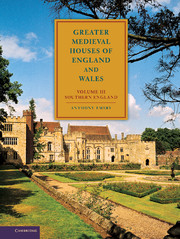Book contents
- Frontmatter
- Contents
- Acknowledgements
- List of abbreviations
- Introduction
- PART I THE THAMES VALLEY
- 1 The Thames Valley: historical background
- 2 The Thames Valley: architectural introduction
- 3 Household expansion, chambers and lodgings
- 4 The Thames Valley: bibliography
- 5 The Thames Valley: survey
- Appendix 1 The Thames Valley castles: residential additionss
- Appendix 2 The Thames Valley: residential licences to crenellate
- PART II LONDON AND SOUTH-EAST ENGLAND
- PART III SOUTH-WEST ENGLAND
- Appendix 5 Castles of south-west England: residential additions
- Appendix 6 South-west England: residential licences to crenellate
- Appendix 7 The architectural value of John Leland and the Buck brothers
- List of plates
- List of figures
- Index
- Index of houses in volumes I, II and III
2 - The Thames Valley: architectural introduction
from PART I - THE THAMES VALLEY
Published online by Cambridge University Press: 05 June 2012
- Frontmatter
- Contents
- Acknowledgements
- List of abbreviations
- Introduction
- PART I THE THAMES VALLEY
- 1 The Thames Valley: historical background
- 2 The Thames Valley: architectural introduction
- 3 Household expansion, chambers and lodgings
- 4 The Thames Valley: bibliography
- 5 The Thames Valley: survey
- Appendix 1 The Thames Valley castles: residential additionss
- Appendix 2 The Thames Valley: residential licences to crenellate
- PART II LONDON AND SOUTH-EAST ENGLAND
- PART III SOUTH-WEST ENGLAND
- Appendix 5 Castles of south-west England: residential additions
- Appendix 6 South-west England: residential licences to crenellate
- Appendix 7 The architectural value of John Leland and the Buck brothers
- List of plates
- List of figures
- Index
- Index of houses in volumes I, II and III
Summary
CASTLES
THREE royal castles guarded the central Thames valley, Windsor, Wallingford, and Oxford, though this last was founded by a leading baron with the Conqueror's consent and came into royal hands during the twelfth century. Wallingford and Oxford were prominent in the war between Stephen and Matilda, and while Oxford had fallen into disrepair by the early fourteenth century, Wallingford was maintained for residential purposes for a further century. To the west, the Severn estuary was guarded by the royal fortresses at Bristol, Gloucester, and St Briavels. Bristol fell into decay during the fifteenth century and Gloucester from the close of that era, but though St Briavels lapsed from its primary purpose as an administrative centre for the royal forest of Dean, it was maintained for its court and prison function until the mid-nineteenth century.
The region shows a broad span of private castles, chronologically, tenurially, and structurally, with three of them retaining substantive evidence. Those of modest defensive capacity such as Ascott d'Oilly, Stratton Audley, and Deddington had been abandoned before the close of the fourteenth century. The stronghold of the Giffards at Brimpsfield was destroyed on the orders of Edward II in 1322 to join the earlier abandoned earthworks and adulterine sites scattered across the region. Nor does anything survive of Banbury Castle, first erected by bishop Alexander of Lincoln in about 1130 as the administrative centre of the bishop's extensive estates in the area. It was almost entirely rebuilt during the early fourteenth century in concentric form with drum towers and a massive gateway and so maintained until the Civil War.
- Type
- Chapter
- Information
- Greater Medieval Houses of England and Wales, 1300–1500 , pp. 15 - 26Publisher: Cambridge University PressPrint publication year: 2006



